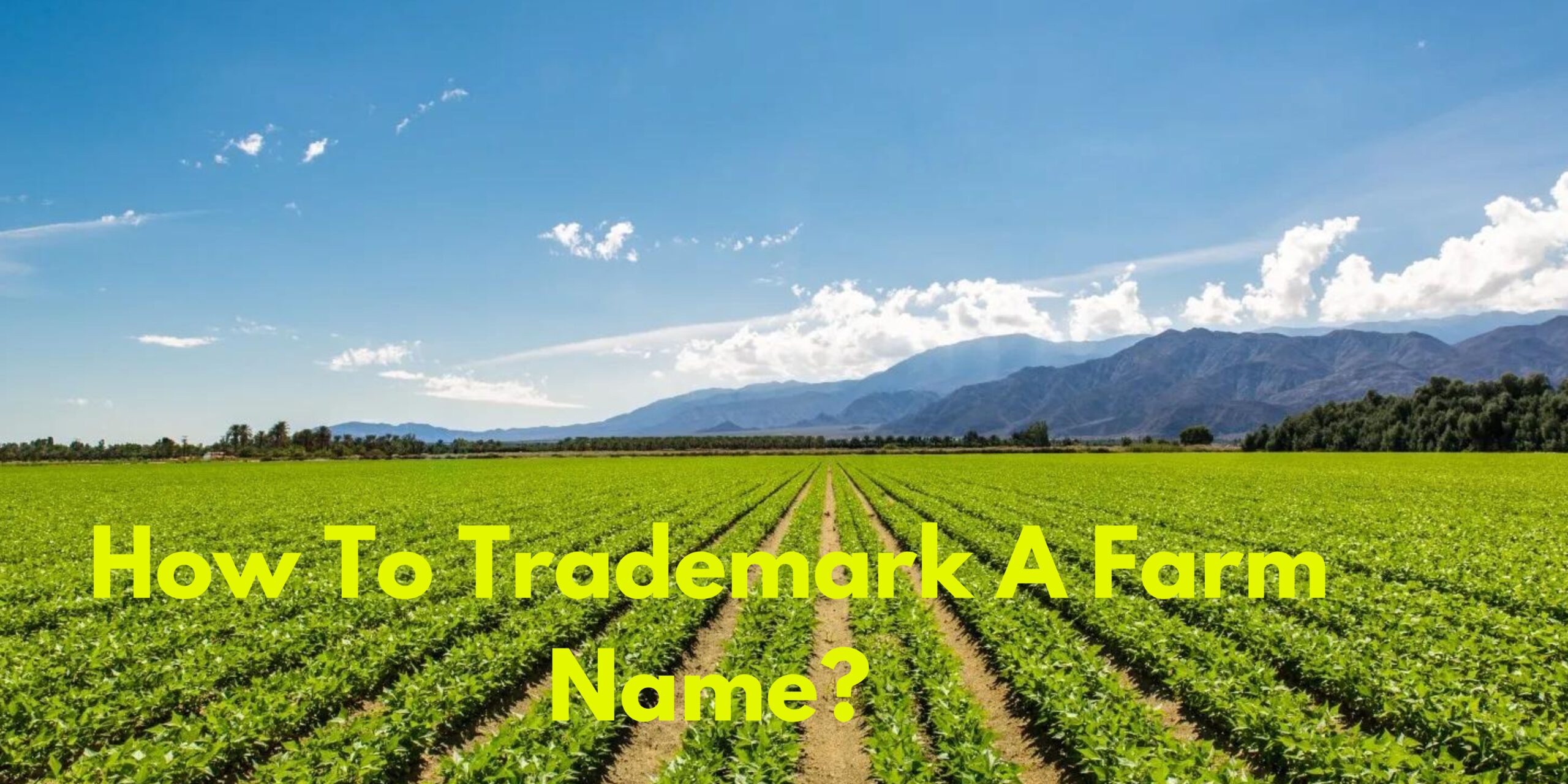How To Trademark A Farm Name?

Table of Contents
In the agricultural industry, a farm name can be a crucial part of your brand identity. Trademarking your farm name is an essential step to protect your brand and ensure that it remains uniquely yours.
Here’s to learning how to trademark a farm name.
How to Trademark a Farm Name
Step 1: Decide How to File
Before starting the trademarking process, decide how you want to file your application. You have three main options:
- Direct Filing with USPTO
- File directly with the United States Patent and Trademark Office (USPTO). This option is the most cost-effective but requires you to handle all aspects of the application yourself.
- Online Legal Services
- Use online legal services that specialize in trademark registrations. These websites can simplify the process and ensure that your application is correctly filed.
- Hiring a Trademark Attorney
- Hire a trademark attorney to handle the process for you. This option is the most expensive but provides expert guidance and increases the likelihood of a successful application.
Step 2: Review the Current Fee Schedule
The USPTO updates its fee schedule periodically. Before submitting your application, review the current fees to understand the costs involved. Being aware of the fees upfront helps you budget for the trademarking process and avoid surprises.
Step 3: Conduct a Thorough Search
Conduct a search in the USPTO’s Trademark Electronic Search System (TESS) to ensure that no similar trademarks are already registered. This step is crucial to avoid potential legal issues and application rejection.
Tips for a Comprehensive Search:
- Search Variations: Look for different variations of your farm name, including common misspellings and similar sounding names.
- Related Classes: Check for similar names in related classes of goods or services.
- Review Abandoned Trademarks: Understand why previous trademarks were abandoned, as this can provide valuable insights.
Step 4: Prepare Your Application
File your trademark application through the USPTO’s Trademark Electronic Application System (TEAS). Here’s what you’ll need to include in your application:
- Statement of Use: A declaration that you are using the farm name in commerce.
- Examples of Use: Evidence showing that you are using the farm name, such as product labels, packaging, or promotional materials.
- Trademark Drawing: A visual representation of the trademark. This should be a clear and precise image of your farm name as it appears on your products or marketing materials.
- Specimen of Use: A sample showing how the trademark is used in the marketplace. This could be a label, packaging, or an advertisement.
- Filing Fee: The cost associated with filing your application.
Step 5: Monitor and Enforce Your Trademark
Once you have successfully trademarked your farm name, it is essential to actively monitor and enforce your trademark rights.
Monitor Your Trademark
Regularly check the marketplace and online platforms to ensure that no one is using your trademarked farm name without permission. Set up alerts and periodically review relevant sites to stay informed about potential infringements.
Take Action Against Infringement
If you discover unauthorized use of your farm name, take immediate action. Here’s how to handle infringement:
- Cease and Desist Letter: Send a formal letter demanding that the infringer stop using your trademarked farm name.
- Negotiation: If the infringer responds, you may be able to reach a resolution, such as stopping use or agreeing to a licensing arrangement.
- Legal Action: If necessary, consult with a trademark attorney and consider filing a lawsuit for trademark infringement.
Costs of Trademarking a Farm Name
The cost to trademark a farm name varies depending on the filing option you choose. Here are the three basic options provided by the USPTO:
Direct Filing Fees
When you file directly with the USPTO’s TEAS, you can choose from three basic options:
- TEAS Plus
- Basic Filing Fee: $250 per class of goods or services.
- Additional Class Fee: $125 for each additional class.
- Email Communications: Required for further communications.
- TEAS Reduced Fee (TEAS RF)
- Basic Filing Fee: $275 per class of goods or services.
- Additional Class Fee: $125 for each additional class (payable later).
- Email Communications: Required for further communications.
- TEAS Regular
- Basic Filing Fee: $350 per class of goods or services.
- Additional Class Fee: Fees apply for adding classes of goods and services.
Additional Costs
Beyond the basic filing fees, you might incur additional costs if you hire a trademark attorney or use a legal website for assistance. These costs can vary widely, so choose the option that best fits your budget and needs.
Case Studies: Successful Farm Trademarks
Case Study 1: Happy Valley Farms
By trademarking the “Happy Valley Farms” name, the farm has secured its brand identity, ensuring that its name remains exclusively associated with its high-quality organic produce. This protection has allowed Happy Valley Farms to expand its market presence without fear of brand dilution or infringement. The trademark has also facilitated the farm’s entry into new markets, including farmers’ markets, grocery stores, and online sales, by providing a recognizable and trusted brand.
Case Study 2: Sunnybrook Vineyards
Trademarking “Sunnybrook Vineyards” has helped protect the vineyard’s reputation for excellence in wine production. This legal protection ensures that only Sunnybrook can use its name and logo, preventing other vineyards from confusing consumers with similar branding. The trademark has also enabled Sunnybrook Vineyards to develop a line of branded merchandise, including wine glasses and apparel, enhancing customer loyalty and brand recognition.
Case Study 3: Green Acres Dairy Farm
The trademark protection for “Green Acres Dairy Farm” has allowed the farm to build a strong brand identity that stands out in the competitive dairy market. This trademark has prevented other dairy producers from using similar names or logos, ensuring that customers associate the Green Acres name with quality dairy products. Additionally, the trademark has supported the farm’s marketing efforts, making it easier to promote its products both locally and nationally.
Case Study 4: Blue Mountain Orchards
Trademarking “Blue Mountain Orchards” has protected the farm’s brand from competitors attempting to use similar names. This legal protection has reinforced the farm’s reputation for producing premium fruits, helping it to secure contracts with major grocery chains and expand its distribution network. The trademark has also enabled Blue Mountain Orchards to offer branded products, such as apple cider and preserves, further enhancing its brand recognition and customer loyalty.
Contact Us
If you have any questions or need assistance with trademarking your farm name, our team of experts is here to help. We offer comprehensive support and guidance throughout the trademarking process to ensure your business name is protected. Whether you choose to file directly, use online legal services, or hire an attorney, being informed about the trademarking process and its associated costs will help you make the best decision for your business. Take the necessary steps today to trademark your farm name and secure your place in the competitive market.

Sissie Hsiao
Sissie Hsiao is the Vice President of Content Marketing and an innovator at heart. With a deep expertise in law, she specializes in the cutting-edge application of trademark and copyright. Sissie's unique blend of legal knowledge and marketing acumen drives her passion for developing forward-thinking content strategies that protect and promote creative works.




